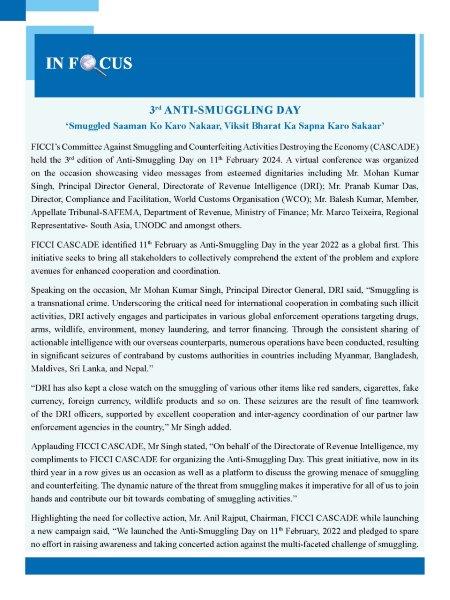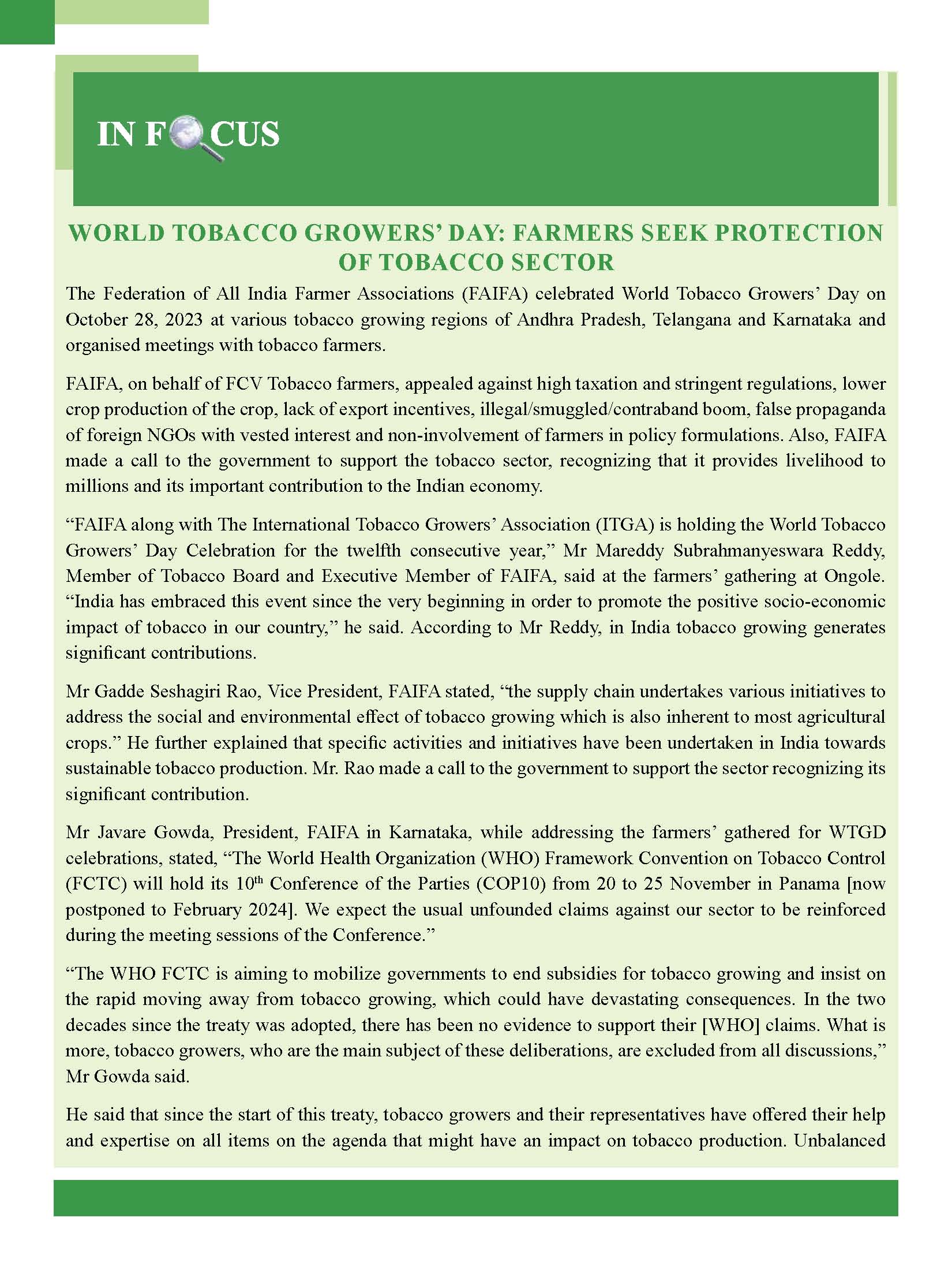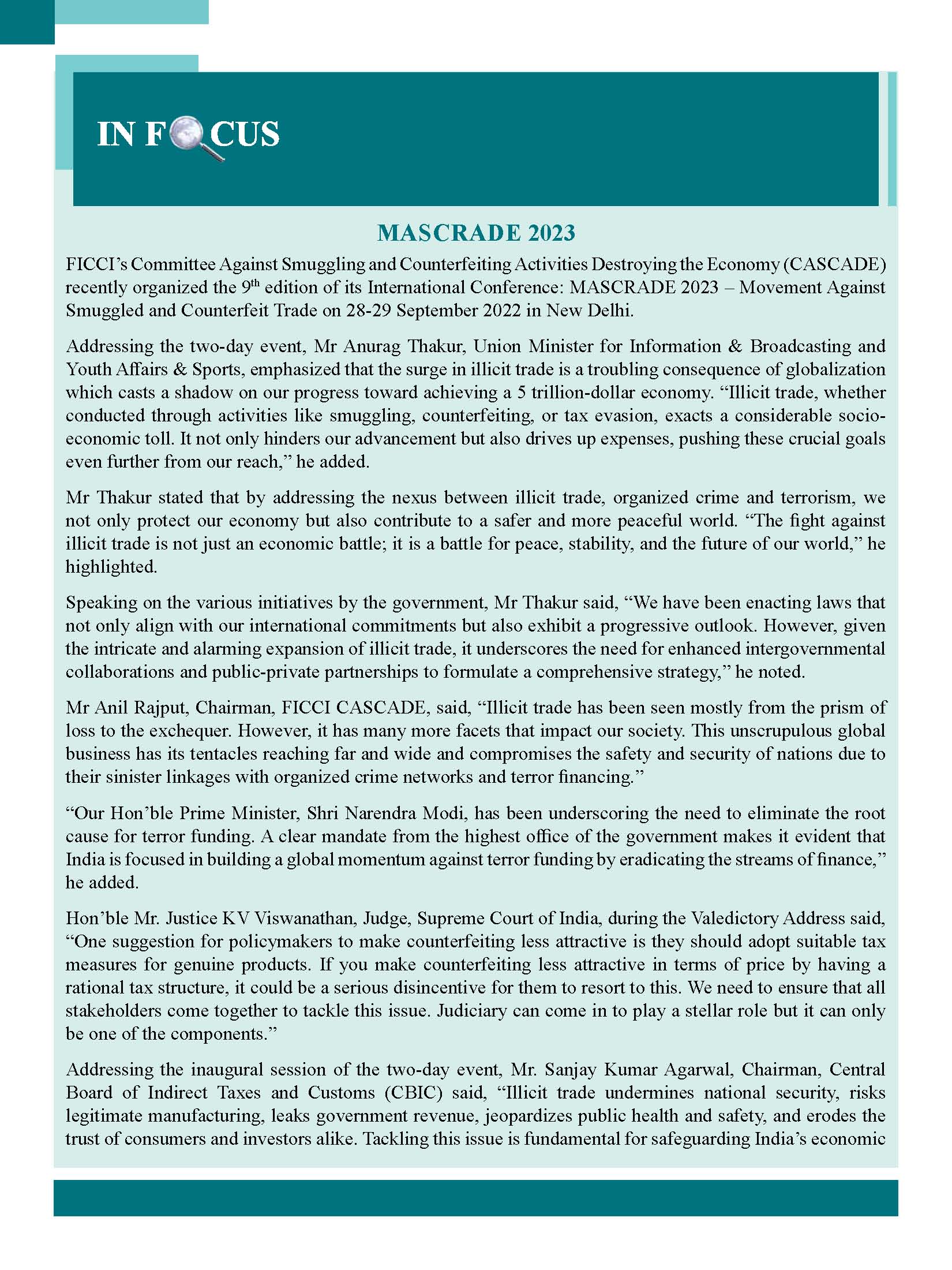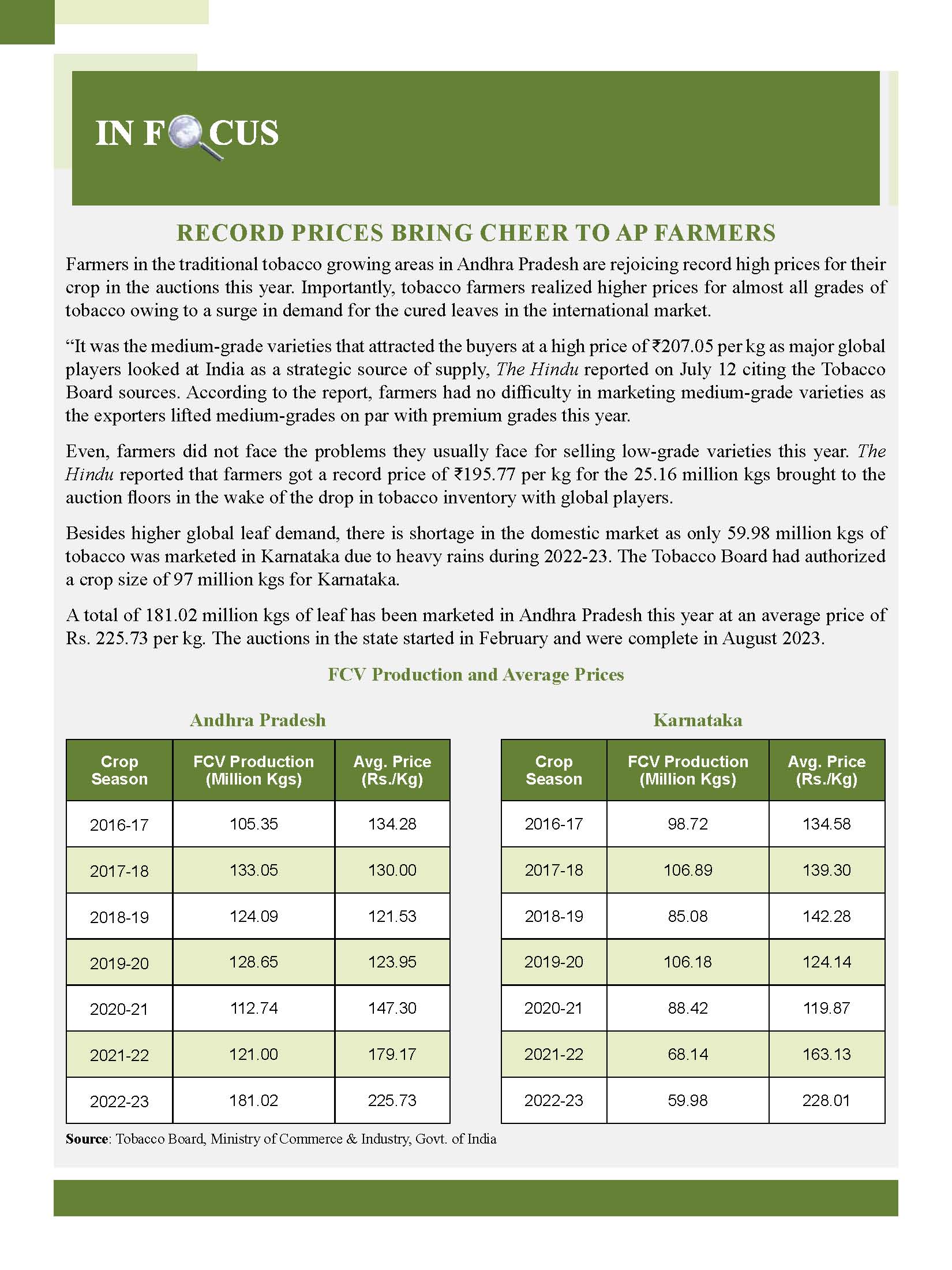The Union Ministry of Health & Family Welfare mandated an increase in the size of pictorial warnings from 40% on front of the packs to 85% on both sides with effect from 1st April 2016.
The Government has taken such an extreme position on warnings overlooking the huge livelihood dependency and enormous socio-economic benefits of Tobacco in India. Being the world’s 2nd largest producer, tobacco is an extremely important commercial crop for India. It provides livelihood to more than 45.7 million people, including farmers, farm labour, rural poor, women, tribals etc.,70% of whom are engaged in the agricultural sector.
Tobacco products generate Tax revenues amounting to more than Rs.72,000* crores annually. In addition, foreign exchange earnings through the export of tobacco & tobacco products garner more than Rs.12,000 crores per annum.
Tobacco is grown in semi-arid and non-irrigated lands where no other remunerative cultivation is possible. In such a situation, the excessively large 85% warnings are having a severe impact on the livelihood of farmers and other industry stakeholders by providing a huge boost to the illegal cigarette trade in the country. The unfettered growth in illegal cigarette trade is adversely impacting farmer incomes, the livelihood of millions dependent on the legal Industry and affecting Government’s revenue collections.
40% pictorial warnings were adequate to inform & caution consumers
The Cigarettes and Other Tobacco Products (Prohibition of Advertisement and Regulation of Trade and Commerce, Production, Supply and Distribution) Act, 2003 (“COTPA”) requires the warnings to be legible, prominent and conspicuous which was fully met by specified health warning covering 40% of the front panel of packs. The 40% warning requirement was decided upon by a Group of Ministers constituted in 2007 to evaluate pictorial warnings.
Moreover, the Global Adult Tobacco Survey (GATS) 2009-10, conducted by the Ministry of Health and Family Welfare, had found that 71% of cigarette consumers were aware of the warnings within a few months of the implementation of pictorial warnings in the country.
Apart from pack warnings retail outlets are mandated to display boards prominently with a warning of size 60 x 30 cm. These warnings also help to caution the consumers.
Hence, it is clear that the 40% pictorial warning on the front of the pack were adequately serving the purpose of cautioning the consumers.
Leading tobacco producing countries do not have excessively large warnings
Pictorial warnings in India are presently mandated to cover 85% of the front and back of tobacco product packs. By virtue of this, India is ranked ninth in the world, by the size of warnings, whereas the global average warning size is less than 45%. Among the top five tobacco producing countries, India has the largest sized pictorial warning on packs at 85%, followed by Brazil at 65% while USA, China and Zimbabwe have textual warnings only.
Large tobacco consuming countries have only text based warnings
United States, China and Japan, between them accounting for more than 50% of global cigarette consumption, have not opted for pictorial warnings. Instead, they have opted for text-based warnings which adequately caution the consumers.
| Country | Annual Cigarette Consumption*(Billions) in 2021 | Per Capita Adult Cigarette Consumption** (Sticks) | Warning Size*** |
|---|---|---|---|
| USA | 239 | 897 | Text (only on side panel) |
| China | 2414 | 1971 | Text – 35% (front & back) |
| Japan | 140 | 1133 | Text – 51% (front & back) |
| India | 87# |
90 | Pictorial – 85% (front & back) |
*https://www.tma.org; **The Tobacco Atlas – 7th Edition (Vital Strategies), 2022
***Canadian Cancer Society’s Cigarette Package Health Warnings – October 2023;
#Cigarette Clearances from TII Member companies (Shipment from Factories)
Excessively large pictorial warnings have many undesired consequences:
Extreme Large warnings promotes shift in tobacco consumption to regulation non-compliant tobacco products
The tobacco consumption pattern in India is unique in that only 9% of total tobacco is consumed in the form of legal Cigarettes. The remaining 91% consumption is in form of 29 cheaper tobacco products such as bidis, chewing tobacco , khaini etc and illegal cigarettes. This is unlike western countries, where cigarettes are the dominant form (>90%) of consumption.
The legal cigarette industry in India is in the organized sector, is licensed and is completely compliant with all tobacco control and other regulations while the bulk (68%) of tobacco consumed is largely produced in the unorganized sector where compliance and enforcement are extremely difficult.
This large unorganized sector pays little tax either due to tax exemptions or evasion. The products from this sector are cheaper, have little statutory oversight and do not comply with regulations under Cigarettes and Other Tobacco Products (Prohibition of Advertisement and Regulation of Trade and Commerce, Production, Supply and Distribution) Act, 2003 (COTPA).
As a consequence, despite the regulatory framework, consumption has shifted to low priced, low revenue yielding, non-compliant alternatives which are largely in the un-organized sector and to illegal products.
The extreme regulatory measure of excessive and large warnings is exacerbating the situation and further impacting the small organized sector resulting in rapid increase in overall consumption, thereby defeating the objectives of tobacco control.
Read more on the Unique Nature of Tobacco Consumption in India
Extreme 85% Pictorial Warning has provided a huge Fillip to the already large and growing Illegal Trade in Cigarettes
The thrust of tobacco regulations (like Pictorial Warnings) has been on the legal cigarette segment of the tobacco industry. It provides a huge impetus to the illegal cigarette trade which is not -compliant with regulations in the country. As a result, illegal cigarette trade has received a huge boost. According to a recent study by Indian Market Research Bureau (IMRB) a part of Kantar Group, the world’s second largest Research, Insight and Consultancy Network, as a result of the change (implementation of 85% pictorial warnings), consumers have begun to demonstrate a noticeable preference for smuggled cigarettes which are freely available in the India market without the prescribed warnings and convey the impression that these are safer alternatives compared with legal cigarettes.
With the regulations -compliant Legal Cigarette Industry already under huge stress of escalating taxes the extreme regulatory regime of excessive pictorial warnings is further eroding the volume base of domestically manufactured legal cigarettes and its entire value chain with contraband products receiving an added incentive.
Source: Euromonitor International, 2023
By not adhering to the specified warnings under COTPA, illegal cigarette trade undermines the tobacco control policies of the Government and deliberately creates the impression that these products are safer than the legal, regulation-abiding domestic cigarettes.
Another dangerous outcome of the increasing illegal trade is that it encourages the entry of organized criminal & terrorist syndicates, which could have serious consequences for the maintenance of law and order in the country. Internationally it has been reported, for example recently by The US Department of Homeland Security, that illegal profits from cigarette smuggling have been used to fund criminal activities.
Read more on rapidly growing Illegal Cigarette Trade in India
Livelihood of Tobacco Farmer is adversely impacted due to reduction in demand for Cigarette tobaccos
The growing illicit cigarette trade induced by excessive taxation and overregulation which has led to a drop in legal cigarettes have had a severe impact on the Indian FCV tobacco farmers. The famers are under tremendous pressure due to the fall in demand for tobaccos grown by them, as contraband products do not use locally grown tobaccos.
Notably, there had been a drop of 40% in FCV tobacco production in the country from a level of 316 million kgs in 2013-14 to 189 million kgs in 2021-22. This caused loss of an estimated 35 million man-days of employment in the tobacco growing areas in the country and huge shrinkage in farmer earnings.
The pragmatic tax policy of recent years has resulted in the recovery of legal volume and higher demand for domestic FCV tobaccos. Consequently, FCV crop production during 2022-23 was higher (241 million kgs), however, it still remains well below the levels attained in 2013-14 (316 million kgs).
Historically, it has been seen that extreme regulations produce counter-productive results. They do not reduce demand for tobacco, but merely shift it from the legal segment to cheaper, regulation non-compliant illegal options of suspect quality, thereby undermining public health objectives.
The distress of cigarette tobacco farmers and others dependent on tobacco for their livelihood makes it very important for policy makers in India to strike a balance between the country’s extreme regulations such as large pictorial warnings and the livelihood of millions of people.
* Revenue generated by Tobacco products including pan masala as per Lok Sabha, Unstarred Question No. 1499 dated 28th July 2023.













